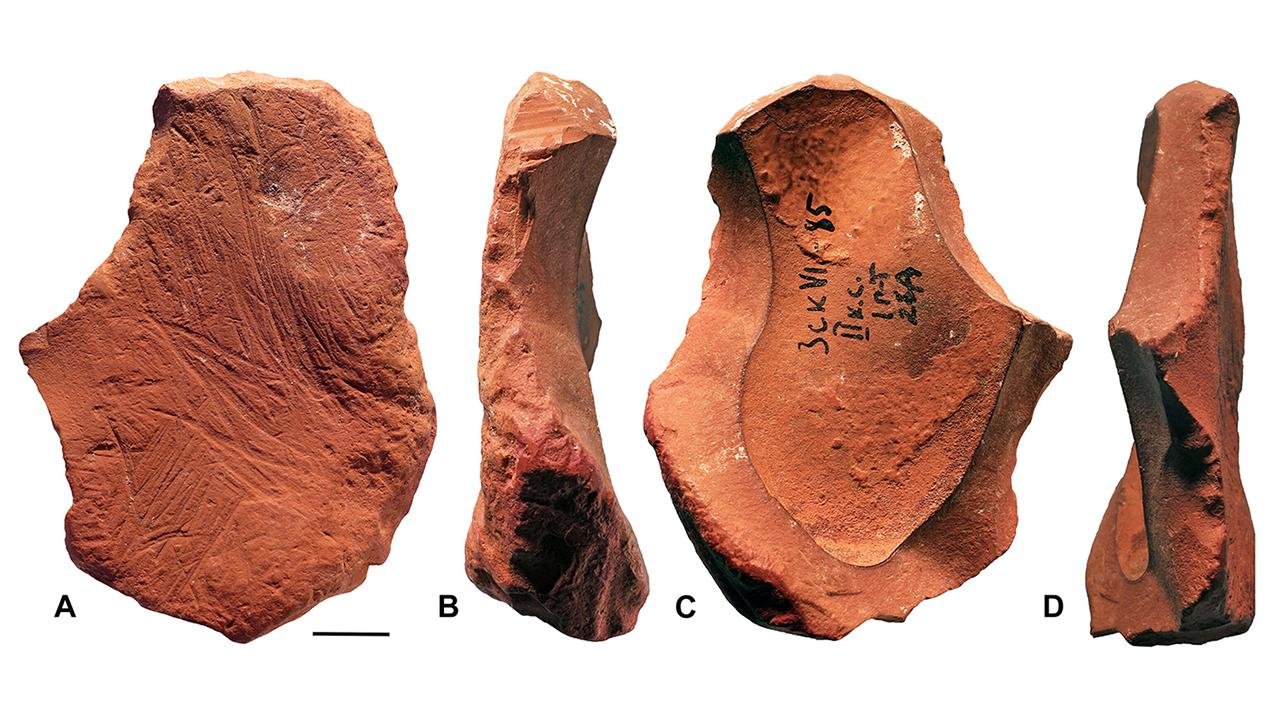A recent archaeological discovery on the Danish island of Tåsinge may challenge decades of theory about the origins of the Sutton Hoo helmet—one of Britain’s most treasured artifacts and often called “Britain’s Tutankhamun.”
 ‘Patrice’ from Tåsinge in Denmark with a motif that connects it to the iconic Sutton Hoo helmet. Credit: The National Museum of Denmark
‘Patrice’ from Tåsinge in Denmark with a motif that connects it to the iconic Sutton Hoo helmet. Credit: The National Museum of Denmark
Two years ago, detectorist Jan Hjort found a small, green-tinged copper alloy object while scanning a field using a metal detector. Initially mistaken for an ordinary picture plate, the discovery was later recognized as a “patrice,” or metal stamp, used for imprinting motifs onto thin metal sheets. The 5-by-4-centimeter object was brought to the Svendborg Museum and later transferred to the National Museum of Denmark for analysis.
Experts, including Peter Pentz, curator at the National Museum of Denmark, have now confirmed that the patterns incised in the stamp bear a remarkable resemblance to those on the Sutton Hoo helmet, unearthed in Suffolk, England, in 1939. The helmet was part of a wealthy Anglo-Saxon ship burial believed to be that of King Raedwald of East Anglia, who died around 624 CE. Alongside the helmet, archaeologists found over 260 artifacts, including gold coins, a shield, and an 88-foot-long burial ship.
 Peter Pentz with the patrician from Tåsinge. Credit: John Fhær Engedal Nissen, The National Museum of Denmark
Peter Pentz with the patrician from Tåsinge. Credit: John Fhær Engedal Nissen, The National Museum of Denmark
Previously, researchers believed that the Sutton Hoo helmet was of Uppland origin in eastern Sweden since its motifs were similar to other Swedish helmets depicting mounted warriors. However, the Tåsinge find has now altered that perspective.
 Motif on ‘patrice’ found by a detectorist on Tåsinge in the Southern Funen archipelago in Denmark. Illustration on motif: Mads Lou Bendtsen, The National Museum of Denmark
Motif on ‘patrice’ found by a detectorist on Tåsinge in the Southern Funen archipelago in Denmark. Illustration on motif: Mads Lou Bendtsen, The National Museum of Denmark
The resemblance goes beyond general style. Both artifacts feature mounted warriors with specific commonalities—a shape of the harness for a horse, a cuff on the warrior’s wrist, and a figure below the horse. Even finer details, including the horse’s tail, nosepiece, and mane, are an exact match. A second, partially reconstructed motif on the Sutton Hoo helmet that had previously been disregarded has also shown even more exact alignment with the Danish stamp.
These results suggest the Sutton Hoo helmet not only could have originated in Denmark but also could have been made by the same craftsmen who made the recently discovered patrice.
 Riding warrior motif from the Sutton Hoo helmet. Illustration: Goran taken, Wikipedia, the free encyclopedia license: CC-BY-SA
Riding warrior motif from the Sutton Hoo helmet. Illustration: Goran taken, Wikipedia, the free encyclopedia license: CC-BY-SA
If confirmed, this theory would significantly alter what historians know about geopolitics in Northern Europe in the 7th century. Denmark, traditionally overshadowed by its more archaeologically conspicuous neighbors England and Sweden, may have been at the forefront of the region’s political and artistic landscape during this period. But Pentz cautioned, “It is still too early to draw any conclusions.”
 The Sutton Hoo helmet. Credit: The Trustees of the British Museum (CC BY-NC-SA 4.0 license)
The Sutton Hoo helmet. Credit: The Trustees of the British Museum (CC BY-NC-SA 4.0 license)
The discovery also raises the potential that Tåsinge was the location of a 7th-century metal workshop, with the additional discoveries of metal scraps in the vicinity and a thin sheet of silver. While the possibility remains that the stamp or the helmet was traded between areas, the weight of stylistic and technical evidence falls on the side of Denmark being the helmet’s true origin.
In order to strengthen their argument, researchers plan to create detailed 3D scans of both the patrice and the Sutton Hoo helmet. The scans will allow for precise comparisons that can either prove or debunk the theory of a shared origin.
The patrice is on public display at the National Museum of Denmark in Copenhagen starting April 1.





